
Agathis australis, commonly known by its Māori name kauri, is a coniferous tree in the family Araucariaceae, found north of 38°S in the northern regions of New Zealand's North Island.
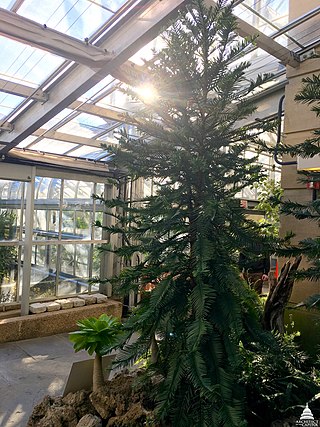
Wollemia is a genus of coniferous trees in the family Araucariaceae, endemic to Australia. It represents only one of three living genera in the family, alongside Araucaria and Agathis. The genus only has a single known species, Wollemia nobilis which was discovered in 1994 in a temperate rainforest wilderness area of the Wollemi National Park in New South Wales. It was growing in a remote series of narrow, steep-sided, sandstone gorges 150 km (93 mi) north-west of Sydney. The genus is named after the National Park.

Agathis, commonly known as kauri or dammara, is a genus of evergreen coniferous trees, native to Australasia and Southeast Asia. It is one of three extant genera in the family Araucariaceae, alongside Wollemia and Araucaria. Its leaves are much broader than most conifers. Kauri gum is commercially harvested from New Zealand kauri.

Podocarpus is a genus of conifers, the most numerous and widely distributed of the podocarp family, the Podocarpaceae. The name comes from Greek πούς + καρπός. Podocarpus species are evergreen shrubs or trees, usually from 1 to 25 m tall, known to reach 40 m (130 ft) at times. The cones have two to five fused cone scales, which form a fleshy, berry-like, brightly coloured receptacle at maturity. The fleshy cones attract birds, which then eat the cones and disperse the seeds in their droppings. About 97 to 107 species are placed in the genus depending on the circumscription of the species.
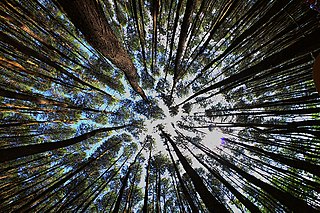
Pinus merkusii, the Merkus pine or Sumatran pine, is a pine native to the Malesia region of southeast Asia, and the only one that occurs naturally south of the equator.

Abies bracteata, the Santa Lucia fir or bristlecone fir, is the rarest and most endemic fir in North America, and according to some, the world. It is confined to steep-sided slopes and the bottoms of rocky canyons in the Santa Lucia Mountains, in the Big Sur region on the central coast of California, United States.

Pinus kesiya is one of the most widely distributed pines in Asia. Its range extends south and east from the Khasi Hills in the northeast Indian state of Meghalaya, to northern Thailand, Philippines, Burma, Cambodia, Laos, southernmost China, and Vietnam. It is an important plantation species elsewhere in the world, including in southern Africa and South America.
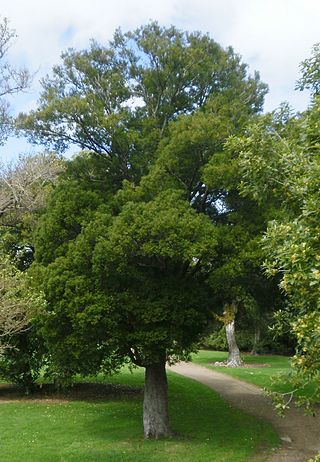
Prumnopitys ferruginea, commonly called miro, is an evergreen coniferous tree which is endemic to New Zealand. Before the genus Prumnopitys was distinguished, it was treated in the related genus Podocarpus as Podocarpus ferrugineus.

Picea engelmannii, with the common names Engelmann spruce, white spruce, mountain spruce, and silver spruce, is a species of spruce native to western North America. It is mostly a high-elevation mountain tree but also appears in watered canyons.

Agathis robusta, commonly known as kauri pine, Queensland kauri (pine) or smooth-barked kauri, is a coniferous tree in the family Araucariaceae. Although sometimes called a pine it is not a true pine, having leaves rather than needles. It has a disjunct distribution, occurring in Papua New Guinea and Queensland, Australia. Populations in Papua New Guinea may be treated as the distinct species Agathis spathulata.

Abies firma, the momi fir, is a species of fir native to central and southern Japan, growing at low to moderate altitudes of 50–1200 m.

Juniperus deppeana is a small to medium-sized tree reaching 10–15 metres in height. It is native to central and northern Mexico and the southwestern United States.

Agathis macrophylla known as Pacific kauri, is a coniferous tree native to the islands of the southwestern Pacific Ocean in tropical humid lowlands and lower montane regions, notably in Fiji, Vanuatu, the Santa Cruz Islands, and the Solomon Islands. The Pacific kauri is one of the largest and fastest growing species in its genus, and is important in forestry.
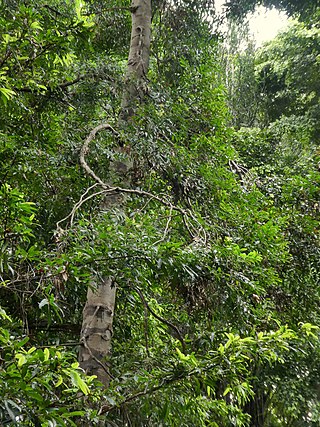
Agathis atropurpurea, commonly known as the blue kauri, and occasionally as the black kauri or purple kauri, is a species of conifer in the very ancient plant family Araucariaceae. The family was distributed almost worldwide during the Jurassic and Cretaceous periods, but is now mostly confined to the Southern Hemisphere. This species is endemic to a small part of northeastern Queensland, Australia.

Agathis microstachya, the bull kauri, is a species of conifer in the family Araucariaceae, endemic to Australia. It was described in 1918 by John Frederick Bailey and Cyril Tenison White. It is threatened by habitat loss.

Agathis ovata, the mountain kauri, is a species of conifer, genus Agathis in the family Araucariaceae. It is found only on the southwest Pacific island of New Caledonia. It is threatened by habitat loss.
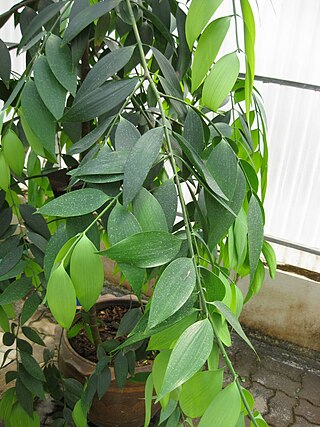
Nageia wallichiana is a species of conifer in the family Podocarpaceae. It is a tree 10–54 m high, found in Brunei, Cambodia, China, India, Indonesia, Laos, Malaysia, Myanmar, Thailand, and Vietnam. Nageia wallichiana is the most widely distributed species among the seven species in the genus Nageia. If the land areas of China and Japan are excluded, its distribution nearly coincides with that of the genus and includes both the western outliers in India and the easternmost part on Normanby Island. It is one of the most extensive conifer ranges recognized and is similar to Dacrycarpus imbricatus and Podocarpus neriifolius.

Pinus henryi, Henry's pine, is a species of conifer in the family Pinaceae.

Retrophyllum rospigliosii is a species of conifer in the family Podocarpaceae. It is a large evergreen tree native to the montane rainforests of Venezuela, Colombia, Peru, Ecuador and Bolivia in South America.
Retrophyllum vitiense is a species of conifer in the family Podocarpaceae. It is a large evergreen rainforest emergent tree native to Fiji, Indonesia, Papua New Guinea, and Solomon Islands.



















